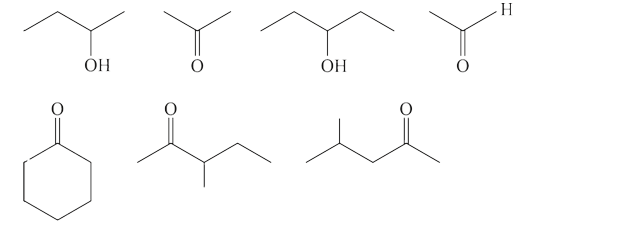An optically active compound
rotates the plane polarised light
changes the direction of polarised light
does not allow plane polarised light to pass through
None of the above
The correct Answer is:A
To solve the question regarding the behavior of an optically active compound with plane polarized light, we can follow these steps:
1. Understanding Plane Polarized Light:
- Plane polarized light consists of waves that vibrate in a single plane. This means that the electric field vectors of the light waves oscillate in one direction.
2. Definition of Optically Active Compounds:
- An optically active compound is a substance that can rotate the plane of polarization of plane polarized light when it passes through it.
3. Behavior of Plane Polarized Light in Optically Active Compounds:
- When plane polarized light travels through an optically active compound, the plane of polarization is rotated by a certain angle. This rotation is a characteristic property of the compound and depends on factors such as the concentration of the compound and the path length of the light.
4. Evaluating the Options:
- Option A: "An optically active compound rotates the plane polarized light."
- This statement is true and correctly describes the behavior of optically active compounds.
- Option B: "Changes the direction of polarized light."
- This statement is misleading. While the plane of polarization is rotated, the direction of the light itself is not changed.
- Option C: "Does not allow plane polarized light to pass through."
- This statement is incorrect. Optically active compounds do allow plane polarized light to pass through; they simply rotate its plane of polarization.
- Option D: "None of the above."
- Since Option A is correct, this option is also incorrect.
5. Conclusion:
- Based on the evaluation of the options, the correct answer is Option A: "An optically active compound rotates the plane polarized light."
- Plane polarized light consists of waves that vibrate in a single plane. This means that the electric field vectors of the light waves oscillate in one direction.
- An optically active compound is a substance that can rotate the plane of polarization of plane polarized light when it passes through it.
- When plane polarized light travels through an optically active compound, the plane of polarization is rotated by a certain angle. This rotation is a characteristic property of the compound and depends on factors such as the concentration of the compound and the path length of the light.
- Option A: "An optically active compound rotates the plane polarized light."
- This statement is true and correctly describes the behavior of optically active compounds.
- Option B: "Changes the direction of polarized light."
- This statement is misleading. While the plane of polarization is rotated, the direction of the light itself is not changed.
- Option C: "Does not allow plane polarized light to pass through."
- This statement is incorrect. Optically active compounds do allow plane polarized light to pass through; they simply rotate its plane of polarization.
- Option D: "None of the above."
- Since Option A is correct, this option is also incorrect.
- Based on the evaluation of the options, the correct answer is Option A: "An optically active compound rotates the plane polarized light."
Topper's Solved these Questions
- WAVE OPTICSBOOK - DC PANDEY ENGLISHCHAPTER - WAVE OPTICSEXERCISE - taking it together
47 Videos
- WAVE OPTICSBOOK - DC PANDEY ENGLISHCHAPTER - WAVE OPTICSEXERCISE - Assertion reason
8 Videos
- WAVE OPTICSBOOK - DC PANDEY ENGLISHCHAPTER - WAVE OPTICSEXERCISE - For JEE Advanced E. Integer Type Questions
13 Videos
- SOLVED PAPERS 2018BOOK - DC PANDEY ENGLISHCHAPTER - SOLVED PAPERS 2018EXERCISE - JIPMER
22 Videos
Similar Questions
Write the name and structrue of the following optically active compounds with lowest moleuclar weight.
i. alkane ii. Alkene
iii. Alkyne iv. unsaturated hydrocabon
v. alkyl halide vi. Alcohol
vii. Acid viii. Amine.
View SolutionAn optically activ compound (A) has the molecular formula C6H10. The compound gives a ppt. When treated with Ag(NH3)2OH. On catalytic hydrogenation, A yields B(C6H14) which is only optically inactive identify the total number of αH in product formed by treatment of A with O3/H2O2 then LAH and then H⊕/Δ
View Solution
Knowledge Check
If (±) 2-methyl butanoic acid were esterified by reaction with (±) 2-butanol, how many optically active compounds would be present in the final equilibrium reaction mixture?
A2B3C4D6
Identify the optically active compounds from the following
View SolutionEnantiomers may possess different rates of reactions with other optically active compounds.
View SolutionNumber of optically active compounds out of following that can give Haloform reactions.

View SolutionThe number of optically active compounds in the isomers of C4H9Br is
View SolutionWhich optically active compound on reduction with LiAlH4 will give optically inactive compound?
View SolutionThe stereochemical formula of diastereomer 'Y' of optically active compound 'X' is,
( If X=2,3− Dihydroxybutanedioic acid. ).
View SolutionCarbene intermediates are produced by the photolysis of diazomethane (CH2N2) or kenene (CH2=C=O). They are also produced by the reaction of CHX3 with base or by Simmons-Smith reaction. There are two types of carbenes, singlet and triplet. They are so called due to their spin state.
An optically active alkene (I) with lowest molecular mass on hydrogenation gives optically inactive alkene, but on insertion of methylene carbene (:CH2) in (I), it gives optically active compound (II). The compounds (I) and (II) are :
 .
.
View Solution